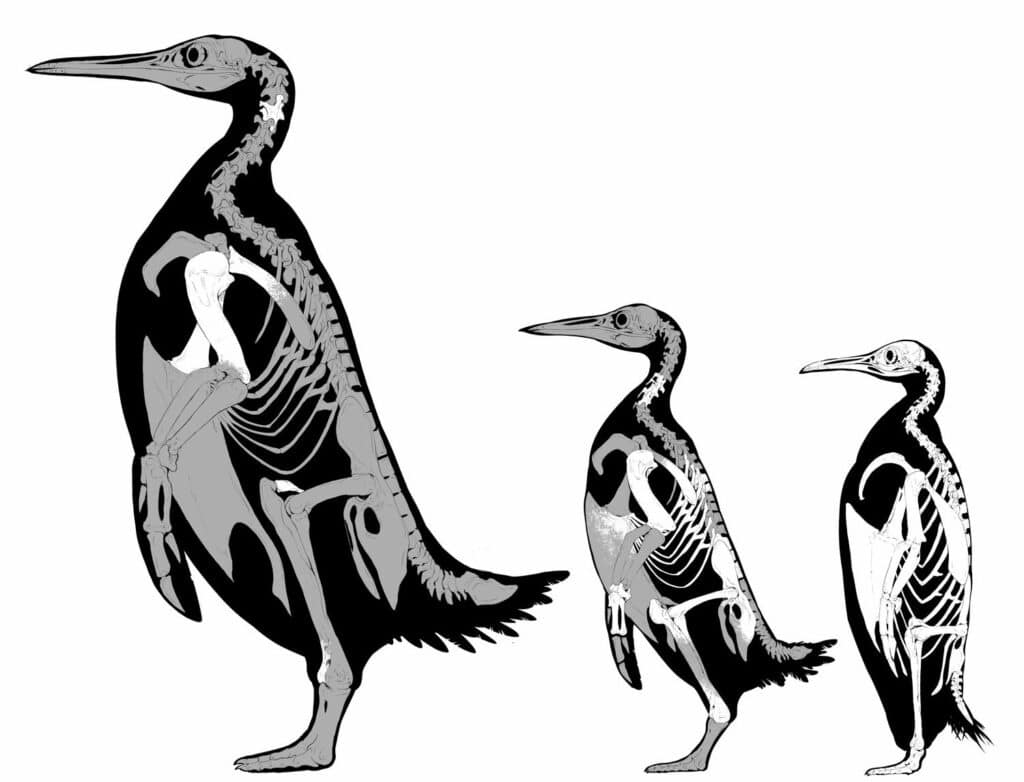Fossils give us information about the evolution of life, and occasionally that information is quite startling. Recent fossil discoveries from New Zealand have revealed a remarkably diverse assemblage of Paleocene stem group penguins.
An international team, including researchers from the University of Cambridge, recently unearthed fossil bones from two newly-described penguin species in New Zealand. One of the penguins is found to be the most giant penguin ever to live.
The fossil suggests that the penguin must be more than three times the size of the largest living penguins, weighing more than 150 Kilograms.
The team initially discovered the fossils in 57 million-year-old beach boulders in North Otago, on New Zealand’s South Island, between 2016 and 2017. The fossils were then exposed from within the boulders by Al Manning. According to their age, which has been estimated to be between 59.5 and 55.5 million years, they lived between five and ten million years after the end-Cretaceous extinction, which also caused the extinction of non-avian dinosaurs.
The team named the new species Kumimanu fordycei in honour of Dr. R. Ewan Fordyce, Professor Emeritus at the University of Otago. The second penguin species, dubbed Petradyptes stonehousei, weighs around 50kg. It is found to be smaller than Kumimanu fordycei but still well above the weight of an emperor penguin. The name combines the Greek’ petra’ for rock and ‘dyptes’ for diver, a play on the diving bird being preserved in a boulder.

To compare the bones to those of other fossil species, flying diving birds like auks, and contemporary penguins, the scientists used laser scanners to generate digital models of the bones. The scientists examined hundreds of modern penguin bones to estimate the size of the new species. They then used the dimensions of the bones in the flippers to determine weight using a regression analysis.
They concluded that a penguin weighing an astounding 154 kg had the largest flipper bones. Emperor penguins, the tallest and heaviest still living, often weigh between 22 and 45 kg.
These two recently discovered species demonstrate that penguins got large sizes millions of years before developing their flipper apparatus. The study discovered that the two species still possessed rudimentary traits such as muscle attachment points that resembled those of flying birds and more thin flipper bones.
Dr. Daniel Ksepka from the Bruce Museum in Greenwich, Connecticut, said, “When asked why early penguins grew to titanic proportions.”
“It made them more efficient in the water. Size conveys many advantages. A bigger penguin could capture larger prey, and more importantly, it would have been better at conserving body temperature in cold waters. It is possible breaking the 100lb size barrier allowed the earliest penguins to spread from New Zealand to other parts of the world.”
Co-author Dr. Daniel Thomas from Massey University in Auckland said, “When we start thinking of these finds not as isolated bones, but as parts of a whole living animal, then a picture begins to form. Large, warm-blooded marine animals living today can dive to great depths. This raises questions about whether Kumimanu fordycei had an ecology that penguins today don’t have, by being able to reach deeper waters and find food that isn’t accessible to living penguins.”
Dr. Daniel Field from Cambridge’s Department of Earth Sciences said, “Kumimanu fordycei would have been an utterly astonishing sight on the beaches of New Zealand 57 million years ago, and the combination of its sheer size and the incomplete nature of its fossil remains makes it one of the most intriguing fossil birds ever found. Hopefully, future fossil discoveries will shed more light on the biology of this amazing early penguin.”
Journal Reference:
- Daniel T. Ksepka et al. ‘Largest-known fossil penguin provides insight into the early evolution of sphenisciform body size and flipper anatomy.’ Journal of Paleontology (2023). DOI: 10.1017/jpa.2022.88
